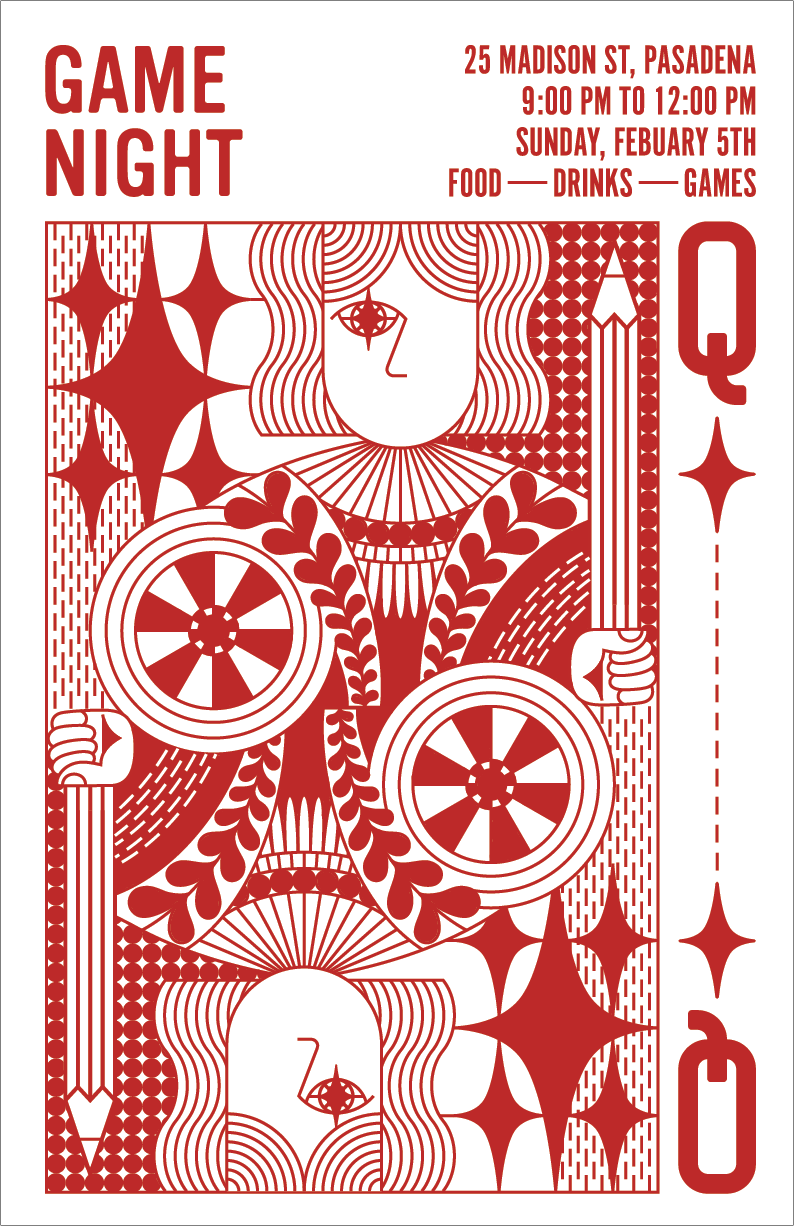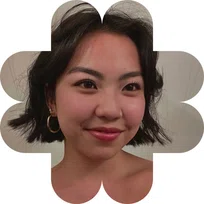

Game Night

Height: 17" x Width: 11" | Material(s): Digital (Adobe Illustrator) | Process(es): Asymmetry, positive/negative space, line and shape, balance, patterns with repetition, poster design | Idea(s): Incorporate symbolism from my life into a playing card design to represent my love for card games. | Curatorial Note: The simple shapes and organization of the elements reflect the same orderliness of the culture it seeks to portray.
Madison Siu
Student statement
Student statement
How did this artwork relate to your sustained investigation inquiry?
My design process is very meticulous, calculated, and intentional. This can clearly be seen throughout the progress of my “Card Game” project. It starts with large, overarching ideas, then narrowing it down, iterating it numerous times, and finally simplifying it into a final product. Not only does it connect to my childhood and current connection of loving to play card games with my family and friends, the visual spread of each stage of this project detail out how I think, as both a person and a designer.
How did you choose your inquiry?
How is my identity reflected in the work I design? Through both the subject/topic of each art piece and the process in which I create them, my inquiry connects my art to who I am as a person. In the three years of learning graphic design, I’ve started to develop a clear design style, a certain process, and a distinct way of thinking about art. The design process is often not apparent when only looking at the final product, but the documentation of my progress for each piece shows the depth of thought that goes into each decision. Through my portfolio and my sustained investigation inquiry, I wanted to highlight this design process while creating pieces that depict my childhood, values, and memories.
Describe how your inquiry evolved as your sustained investigation developed.
The original inquiry I started with was something along the lines of “How can I use poster design to depict my interests and personality?” But throughout the course of the year, my vision for my portfolio became broader. I looked back on past projects to saw a clear design process and a distinguishable design style. My projects represented my attention to detail, my love for typography, my intentional composition and layout, my goal of visual communication, and my artistic style. Not only do my pieces represent my design style, but they each represent a memory or interest of mine.

The iteration and refinement part of the graphic design process aligns with who I am and how I view the world. Every choice throughout each design is intentional and an expression of my life, beliefs, and experiences.
How did your art teacher support your artistic development?
I was one of the first students in my school’s graphic design program, and Ms. Mac provided the space and skills I needed to foster my talent and passion. In my sophomore year, I started my graphic design journey in the Computer Graphic Arts 1 class with her. From there, I followed her through Computer Graphic Arts 2 my junior year, and AP Art my senior year. She taught me from the very basic skills to the more complex ideas. She constantly pushed me to go outside my comfort zone, try out new techniques, and further iterate my designs to create the best version I could. She jokes that even as a math major at Berkeley, in five years I’ll come back and tell her that “I’m a graphic designer now!” So give it four more years; then I’ll come back and let you know.
What is your advice to other AP Art and Design students?
My biggest piece of advice to other AP Art and Design students is that what you do throughout the year will change, so go with it. You may start with one idea, but that idea may evolve over time. But you’ve made it this far, you’ve grown your skills, and you know who you are as an artist. So trust that your portfolio will end up as something beautiful, even if it wasn’t your original plan.
Untitled
Height: 17" x Width: 11" | Material(s): Digital (Adobe Illustrator)
Process(es): Illustration with shape, poster design, shadows and highlights, typography | Idea(s): Take a large, overarching idea, narrow it down, and simplify it into a final product. | Curatorial Note: This piece is a satisfyingly clean approach to representing the student’s identity through food. The simple shapes and organization of the elements reflect the same orderliness of the culture it seeks to portray.
Annemarie McElhattan
Art & Design Teacher
Monte Vista High School, Danville, CA, USA
Teacher statement
Teacher statement
How did you scaffold writing into the art-making and thinking processes?
Students create portfolio sites at Monte Vista and regularly blog about their progress, commenting on each other's work. In AP Studio Art, the students work from prompts based on the AP rubric and choose from a menu of essential skills to boost their ideation process. Blog posts record artist research, ideation, technical development, and revisions for their exam submission. Blogs are posted before each critique so students are prepared to speak confidently about their work. Not all students keep a sketchbook, and the blog serves to preserve all of the content they create.
What creative programming (i.e., exhibit spaces, mentoring programs, curricular supports) have you implemented to support AP Art and Design students?
Getting out and seeing art locally is one of my greatest pleasures as a teacher. We have so many public collections, big and small, in the Bay Area. We had opportunities to sketch “The Gates of Hell” in charcoal at The B. Gerald Cantor Rodin Sculpture Garden at Stanford University, request drawings and prints from Foundation for Graphic Arts at The Legion of Honor to see in person like Grant Wood’s exquisite drawing “The Perfectionist,” and expand our idea of what art can be taking in installation art like “The Visitors” by Ragnar Kjartansson at SFMOMA. These trips can be profound learning experiences and are a great break from the classroom setting.
What did you learn from working with your student?
Madison Siu thinks like a designer. She loves the design process, defining the problem, ideating broadly, economizing solutions, and indulging in the minutiae of finish work on each brief. She is always looking for new tools and applications and seeking out historical and current design trends, sharing with our community what she has learned. More importantly though, Madison puts her skills to work, doing design work for many groups and clubs at our school. She wrote a handbook detailing the planning and production of exhibits for our school gallery because she thought it would help support new exhibitors. She became close with her AP classmates, supporting them and spending time together, both socially and on field trips. She treated all aspects of participation in the program as necessary and valuable to her own practice as a designer, which is evident in the quality of her work.
Madison Siu



